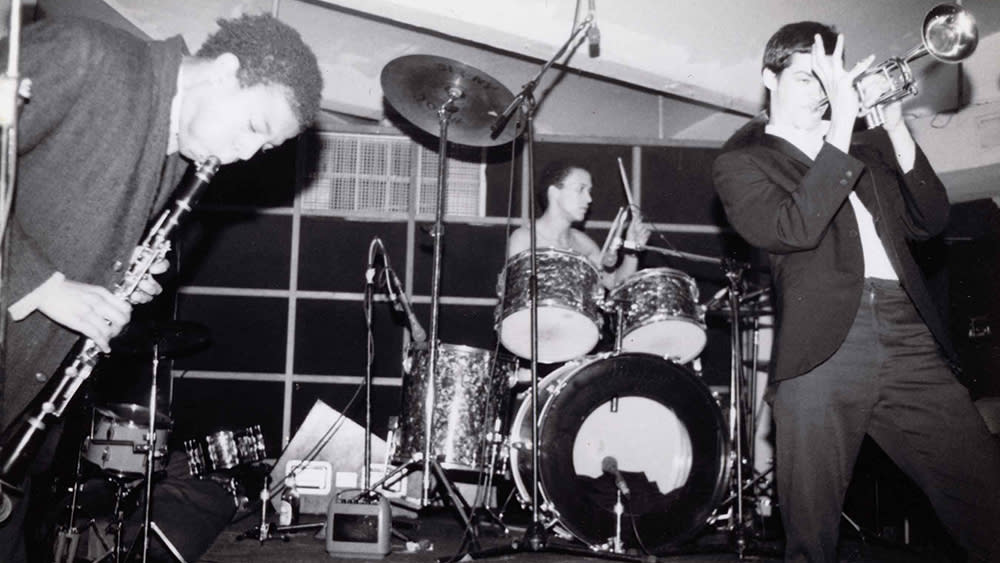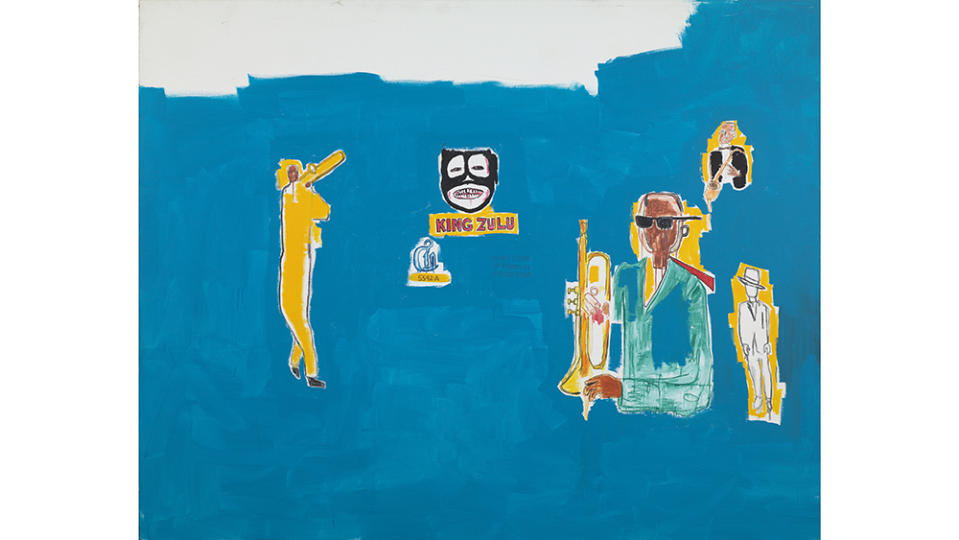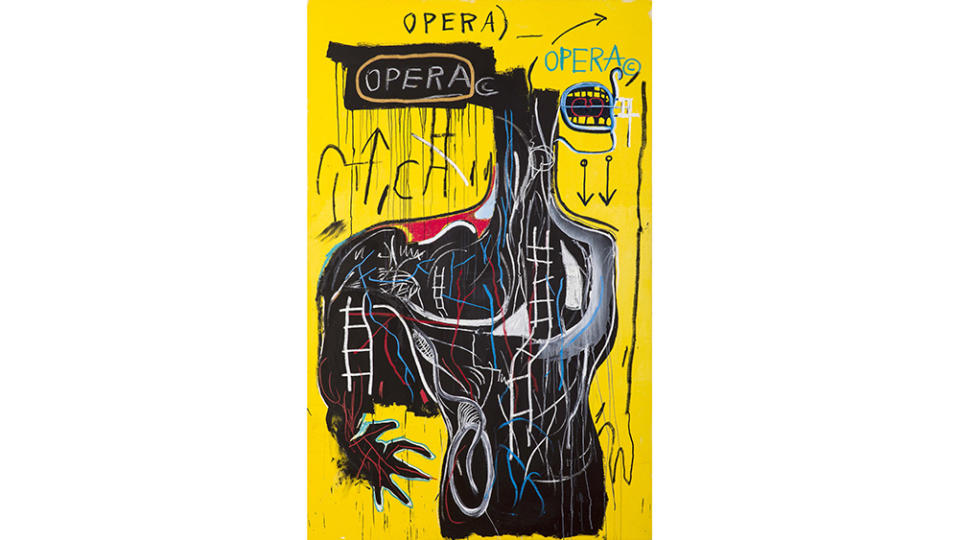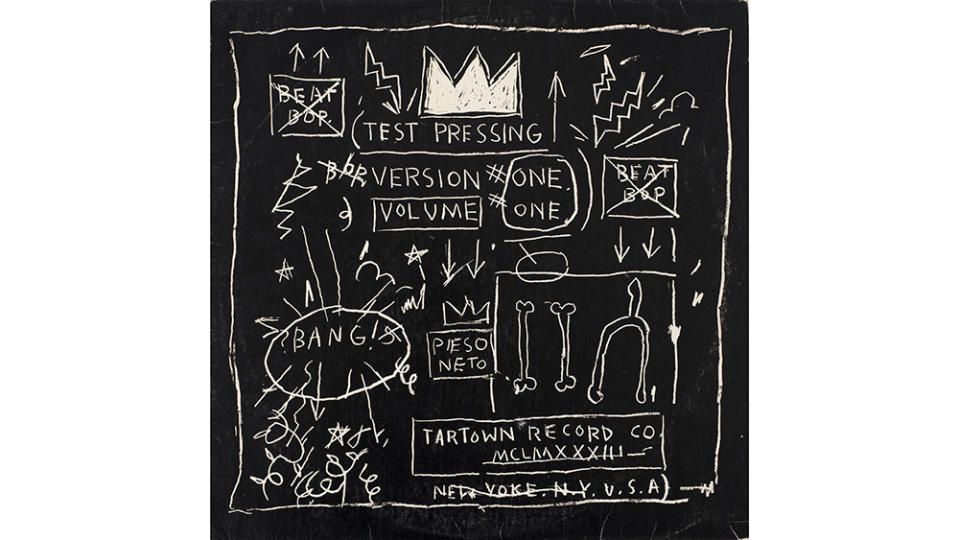The First Exhibition Exploring Basquiat’s Relationship With Music Opens Next Month

- Oops!Something went wrong.Please try again later.
When Jean-Michel Basquiat was growing up in Brooklyn, he would lie on the floor drawing while his father, a music buff, played jazz and classical records. “So for him,” curator Mary-Dailey Desmarais observes, “the hand was making art while the ear was listening to music from a very young age.”
The inextricable link between the visual and the aural in Basquiat’s work is the subject of an exhibition opening this month at the Montreal Museum of Fine Arts. Seeing Loud: Basquiat and Music is the first museum show to offer an in-depth exploration of the musical references and performance history of the neo-expressionist painter, who died of a heroin overdose in 1988 at the age of 27.
More from Robb Report
A Historic London Home Next to Bob Marley's Former Pad Just Listed for $12.4 Million
Oscar-Winning Composer Ryuichi Sakamoto Just Created a Symphony Inspired by Krug Champagne
Hip-Hop's Most Famous Jewelry Takes Center Stage in a Brand New Coffee Table Book
The exhibition will examine not only his direct allusions, such as the image of a banjo or the word “opera,” but also his paintings’ structural similarities to music composition. Evoking jazz’s riffs and hip-hop’s sampling, Basquiat used self-appropriation, in the form of Xerox, in his works. “He’s sampling his own compositions and creating a call-and-response between them,” says Desmarais, the museum’s chief curator.

In 1979, when Basquiat was still a teenager, he heard about the upcoming Canal Zone Party, a showcase for the Fab 5 graffiti crew in downtown Manhattan, and arrived as the organizers were setting up. “This young, handsome Black kid comes charging in and says, ‘I wanna be part of this, too!’ ” recalls Michael Holman, who put together the event with hip-hop trailblazer Fab 5 Freddy and others. “We had no idea who he was, but he was charming and so sure of himself that we said sure.” Handed a can of spray paint, Basquiat started putting his touch on the decor, and the others quickly recognized his work as that of the graffiti duo Samo, whose tags were standouts on the Lower East Side.
Before the party was over, Basquiat asked Holman if he wanted to start a band. “At that time in New York, we were all wanting to be artists, but if you were an artist, you still had to be in a band,” says Holman, who had performed with the Tubes, a San Francisco rock band known for its over-the-top stage shows. “Because that’s how you picked up chicks. That’s how you got laid. You had to be in a band. Everybody was,” he adds, namechecking George Condo, Robert Longo and James Nares.
Basquiat and Holman began recruiting other members the same night. “We decided very early on you had to be cool, you had to look good, but you could not be a formally trained musician,” Holman says. “We did not want that baggage in our band.
“We were going to approach music as sound sculpture,” he continues, citing avant-garde composers John Cage and Karlheinz Stockhausen as influences. The band would find unconventional ways to play instruments—pulling masking tape off a drumhead, running a metal file across electric-guitar strings—make music with random objects and use Basquiat’s poetry as lyrics. Basquiat named the group Gray, after Gray’s Anatomy, the classic medical textbook he referenced for his figuration.

Though several years younger than his bandmates, Basquiat was the obvious, if unofficial, leader. “Jean was a kind and generous person, but he was also super cool, and that was more important,” Holman says. “You didn’t try to ask him to lower his ‘hip’ guard.” The artist, he says, “had the last word on everything.”
As an example, Holman recalls a gig at the Mudd Club, a venue for underground music. The bandmates—minus Basquiat—spent the afternoon building an elaborate set: One member was to sit in a hole in the stage with only his head visible; two others were to be strapped into scaffolding above at 45-degree angles; and a fourth would be positioned so high that only his legs could be seen.
When Basquiat arrived in time for the sound check, he took one look at Holman’s design, then walked out. He returned a few minutes later dragging a large wooden open crate. “He throws the crate up on stage. He squeezes his body into it—he just barely fits—pulls his synthesizer in with him and smiles,” Holman says. “He finds this thing that not only worked with the sculpture but made him the center of attention. He was inside for the whole gig.”

Though Gray played experimental, industrial-sounding music, Basquiat’s painting is most associated with jazz, and Desmarais says he was also influenced by classical, Mississippi Delta blues and hip-hop. He had a collection of some 3,000 records. His interest in music was, she says, not merely as a “soundtrack to his life” but also as an intrinsic channel to his thoughts about race.
“Basquiat repeatedly articulated his disappointment that there were not enough Black heroes represented in the art historical canon,” Desmarais notes. “When you see his paintings of Black musicians, you can see that he is celebrating the legacy of these incredible geniuses, making them visible in art history. You can see in many of these paintings, particularly of jazz and bebop musicians like Charlie Parker, how he identified with them as a Black artist who consistently confronted racism himself. Many of the musicians would be playing in jazz clubs and then not be able to sit down in the restaurant or use the bathroom. Basquiat was one of the most famous artists of his time and couldn’t get a taxi uptown.”
Basquiat left Gray by his early 20s, when his painting career caught fire. But Holman continued to register a connection between his bandmate’s music and his art. “His later work had that ‘ignorance’ to it,” he says, using a jazz slang for something that breaks the rules and shouldn’t work but somehow does anyway, “that deconstruction, humor, rawness, that child’s hand, mixed with things that aren’t supposed to be there, like recipes or a list of leeches in a painting. It just appealed to him. If there’s any common thread, it’s Basquiat’s imagination.”
Best of Robb Report
Sign up for Robb Report's Newsletter. For the latest news, follow us on Facebook, Twitter, and Instagram.

